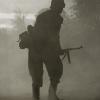
Without further ado, I will be sharing plenty of photographs of these specimen organized primarily by their country of origin. For example, the museum has many aircraft that served with the Royal Air Force, but were manufactured and designed by the United States (B-25 Mitchell, and PBY Catalina for example). Hope you find some entertainment out of it, I sure did.
United States of America:
B-25 Mitchell
F4U Corsair
A-1 Skyraider
United Kingdom:
de Havilland Mosquito
Avro Lancaster
Hawker Hurricane x2, Supermarine Spitfire x2, Avro Lancaster, de Havilland Mosquito
Germany:
Focke-Wulf Fw 190 Würger
Messerschmitt Me 262 Schwalbe
That's all for now. I'll dump the miscellaneous photos of the WWI-era and Cold War era aircraft if they are desired.
As for actual little paragraphs to go along with the aircraft, in the future I shall do so with proper photographs organized by nationality much like my previous two armoured vehicle entries.
- Read more...
- 2 comments
- 3,304 views


